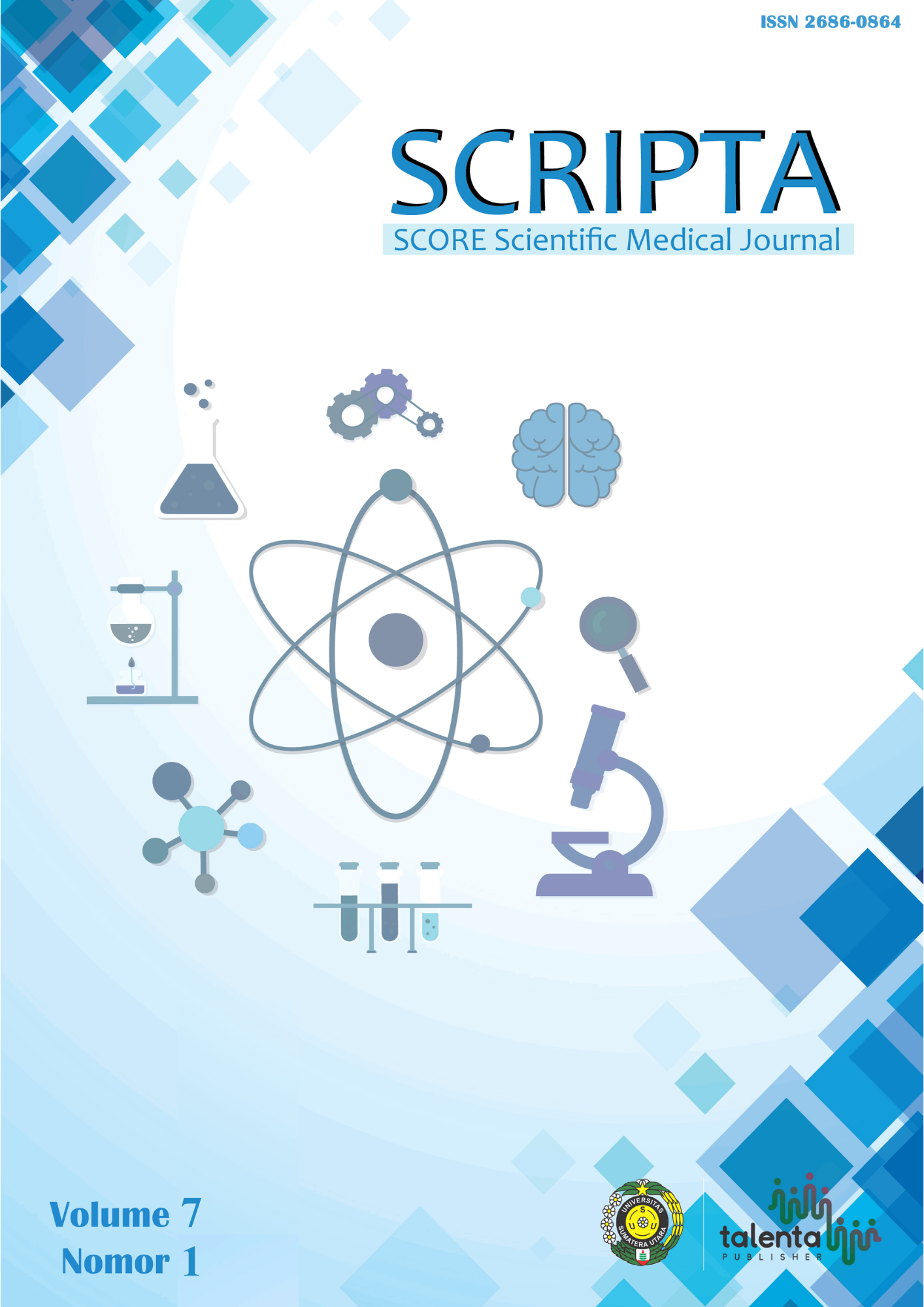The Efficacy and Safety of Tamsulosin and Tadalafil Combination Therapy Compared with Tadalafil Alone for Patients with Benign Prostatic Hyperplasia
DOI:
https://doi.org/10.32734/scripta.v7i1.21200Keywords:
benign prostatic hyperplasia, combination therapy, LUTS, tadalafil, tamsulosin, hiperplasia prostat jinak, terapi kombinasiAbstract
Background: Benign prostatic hyperplasia (BPH) is a common urologic condition in aging men that often manifests as lower urinary tract symptoms (LUTS). Pharmacological management includes α1-adrenoceptor blockers like tamsulosin and phosphodiesterase type 5 inhibitors (PDE5-Is) like tadalafil. Recent studies suggest combination therapy may offer greater symptom relief. Objective: To compare the efficacy and safety of combination therapy with tamsulosin and tadalafil versus tadalafil monotherapy in patients with BPH-related LUTS. Methods: This literature review included randomized controlled trials and prospective studies published between 2008 and 2022. Databases such as PubMed, MEDLINE, Embase, and Cochrane Library were searched using relevant keywords. Twelve studies met the inclusion criteria and were narratively analyzed. Results: Most studies showed that combination therapy was more effective than monotherapy in improving IPSS scores, Qmax, and sexual function, especially in patients with coexisting erectile dysfunction. Fixed-dose combination therapy also improved patient adherence and satisfaction. While tadalafil monotherapy remained effective, particularly in men with mild-to-moderate symptoms, its effect was less consistent in severe LUTS. Conclusion: Combination therapy of tamsulosin and tadalafil provides superior clinical benefit in managing LUTS/BPH, especially in men with concurrent ED. It is generally well tolerated, but individualized therapy based on symptom severity, prostate size, and comorbidities is essential.
Keyword: benign prostatic hyperplasia, combination therapy, LUTS, tadalafil, tamsulosin
Latar Belakang: Hiperplasia prostat jinak (BPH) merupakan kondisi urologis yang umum pada pria lanjut usia dan sering menyebabkan gejala saluran kemih bagian bawah (LUTS). Penatalaksanaan farmakologis meliputi penggunaan α1-adrenoceptor blocker seperti tamsulosin dan penyekat fosfodiesterase tipe 5 (PDE5-I) seperti tadalafil. Studi terbaru menunjukkan bahwa terapi kombinasi dapat memberikan perbaikan gejala yang lebih baik. Tujuan: Membandingkan efektivitas dan keamanan terapi kombinasi tamsulosin dan tadalafil dengan monoterapi tadalafil pada pasien dengan LUTS akibat BPH. Metode: Tinjauan pustaka ini mencakup uji klinis terkontrol acak dan studi prospektif yang diterbitkan antara tahun 2008 hingga 2022. Basis data seperti PubMed, MEDLINE, Embase, dan Cochrane Library digunakan dengan kata kunci relevan. Dua belas studi memenuhi kriteria inklusi dan dianalisis secara naratif. Hasil: Sebagian besar studi menunjukkan bahwa terapi kombinasi lebih efektif dibandingkan monoterapi dalam meningkatkan skor IPSS, Qmax, dan fungsi seksual, terutama pada pasien dengan disfungsi ereksi. Terapi kombinasi dosis tetap juga meningkatkan kepatuhan dan kepuasan pasien. Meskipun monoterapi tadalafil tetap efektif, efeknya kurang konsisten pada gejala LUTS yang berat. Kesimpulan: Terapi kombinasi tamsulosin dan tadalafil memberikan manfaat klinis yang lebih baik dalam penanganan LUTS/BPH, khususnya pada pasien dengan disfungsi ereksi. Terapi ini umumnya ditoleransi dengan baik, namun pilihan terapi harus disesuaikan secara individual berdasarkan tingkat keparahan gejala, ukuran prostat, dan komorbiditas.
Kata Kunci: hiperplasia prostat jinak, LUTS, tamsulosin, tadalafil, terapi kombinasi
Downloads
Downloads
Published
How to Cite
Issue
Section
License
Copyright (c) 2025 Mochammad Haikal Alhamdi, Siti Nurhijrati Hasanah

This work is licensed under a Creative Commons Attribution-NonCommercial 4.0 International License.
Authors who publish with SCRIPTA SCORE Scientific Medical Journal agree to the following terms:
- Authors retain copyright and grant SCRIPTA SCORE Scientific Medical Journal right of first publication with the work simultaneously licensed under a Creative Commons Attribution-NonCommercial License that allows others to remix, adapt, build upon the work non-commercially with an acknowledgment of the work’s authorship and initial publication in SCRIPTA SCORE Scientific Medical Journal.
- Authors are permitted to copy and redistribute the journal's published version of the work non-commercially (e.g., post it to an institutional repository or publish it in a book), with an acknowledgment of its initial publication in SCRIPTA SCORE Scientific Medical Journal.














